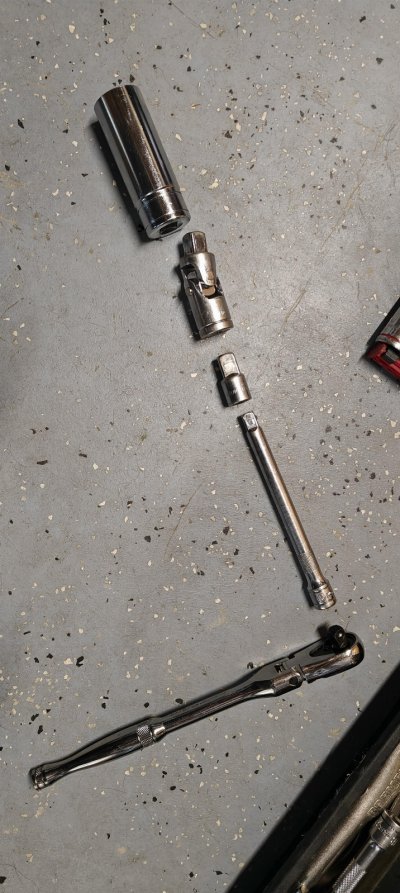To be clear. That means there is a problem found in that "system" but not necessarily the sensor itself. Could only be the screen but no one replaces the screen without changing the sensor and screen Could also be wiring to sensor and 10 new sensors/screens would not fix it. Could also be a oil pressure problem. Lots of choices but the %'s usually are the sensor and screen.P0521 - Engine Oil Pressure (EOP) Sensor Performance
You are using an out of date browser. It may not display this or other websites correctly.
You should upgrade or use an alternative browser.
You should upgrade or use an alternative browser.
low oil pressure long trip
- Thread starter oldskier
- Start date
Disclaimer: Links on this page pointing to Amazon, eBay and other sites may include affiliate code. If you click them and make a purchase, we may earn a small commission.
Charlie207
Full Access Member
I also recently had this issue of pressue reporting very low via the dash gauge. I did the following procedure during an oil change with filter removed.
I would start by pulling the sensor and screen, and cleaning out the orifice/hole in the sensor really good with brake cleaner and a soft pick of some sort. Reinstall the sensor with no screen; it's probably trashed now anyways from getting it out of the engine block. (You want to eliminate variables of the screen to see if it's just a clogged sensor orifice.)
Blow out the sensor hole in the block with air or brake cleaner to get rid of the tiny gunk.
Reinstall the sensor, finish oil change, and go for a drive.
Pay attention to the pressure level, and how much faster the dash gauge responds to engine load & RPM.
If there is a big change/improvement, then it was probably a gunked-up screen and sensor, like mine. Pulling out the screen and blasting out that tiny orifice in the sensor instantly fixed the reporting problem.
Here is my socket setup using the "OEM Tools" sensor socket from AutoZone (or O'Reilly's):

It's a 10 minute job now to get the oil pressure sensor out/in after doing it once before to replace it (which didnt really solve the low psi issue last year).
Pull engine cover.
Unplug vacuum hose from brake booster, and tuck it to the left of the engine, out of the way.
Reach back and unclip sensor harness. Pinch one side of harness and wiggle up. Move harness & cable to the left of everything.
Place socket (3/4 drive), u-joint, and 3/4 > 3/8 adapter onto sensor as one unit. Attach 6" 3/8 extension and ratchet, and give it a crank to loosen. Once loose, you can remove extension and socket, and hand-loosen the sensor.
It's tight, and you'll do some planks on the radiator support to reach it, unless you can convince a small child to sit up there and route all the stuff & things, so you only have to mash the ratchet to loosen the sensor.
I would start by pulling the sensor and screen, and cleaning out the orifice/hole in the sensor really good with brake cleaner and a soft pick of some sort. Reinstall the sensor with no screen; it's probably trashed now anyways from getting it out of the engine block. (You want to eliminate variables of the screen to see if it's just a clogged sensor orifice.)
Blow out the sensor hole in the block with air or brake cleaner to get rid of the tiny gunk.
Reinstall the sensor, finish oil change, and go for a drive.
Pay attention to the pressure level, and how much faster the dash gauge responds to engine load & RPM.
If there is a big change/improvement, then it was probably a gunked-up screen and sensor, like mine. Pulling out the screen and blasting out that tiny orifice in the sensor instantly fixed the reporting problem.
Here is my socket setup using the "OEM Tools" sensor socket from AutoZone (or O'Reilly's):

It's a 10 minute job now to get the oil pressure sensor out/in after doing it once before to replace it (which didnt really solve the low psi issue last year).
Pull engine cover.
Unplug vacuum hose from brake booster, and tuck it to the left of the engine, out of the way.
Reach back and unclip sensor harness. Pinch one side of harness and wiggle up. Move harness & cable to the left of everything.
Place socket (3/4 drive), u-joint, and 3/4 > 3/8 adapter onto sensor as one unit. Attach 6" 3/8 extension and ratchet, and give it a crank to loosen. Once loose, you can remove extension and socket, and hand-loosen the sensor.
It's tight, and you'll do some planks on the radiator support to reach it, unless you can convince a small child to sit up there and route all the stuff & things, so you only have to mash the ratchet to loosen the sensor.
Last edited:
I agree with Charlie but caution against removing the screen in an engine that still has active AFM components. As I understand it (which could be wrong), that screen plays a role in protecting the tiny oil passages in the VLOM and lifters from debris. In an active AFM engine, I would replace both the sensor and screen.
Charlie207
Full Access Member
I agree with Charlie but caution against removing the screen in an engine that still has active AFM components. As I understand it (which could be wrong), that screen plays a role in protecting the tiny oil passages in the VLOM and lifters from debris. In an active AFM engine, I would replace both the sensor and screen.
I agree with needing a screen if AFM is still active.
If you need a quick way to troubleshoot, I would hope 5 minutes of driving wouldn't hurt the system with a missing screen, especially after a fresh oil & filter change.
